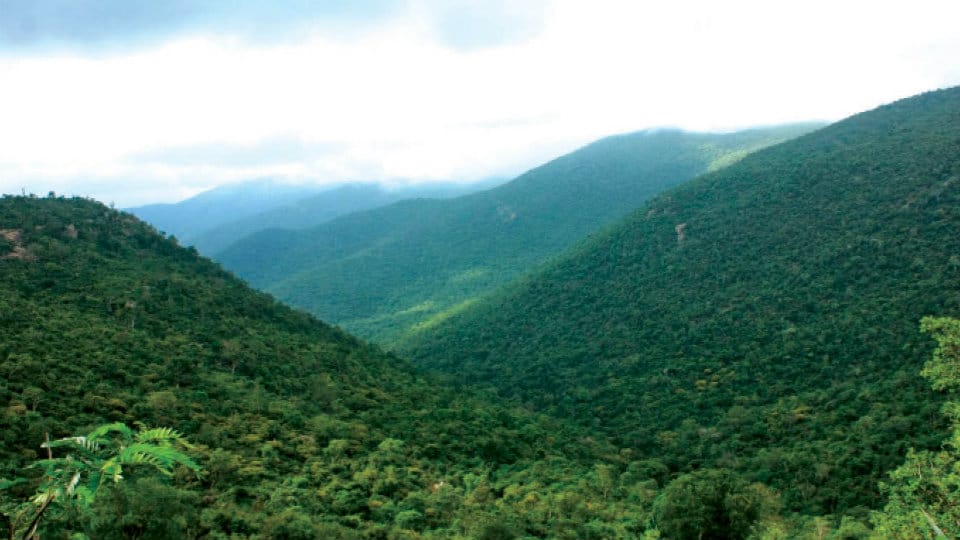Chamarajanagar to be the only district in India to have three Tiger Reserves
Chamarajanagar/ Mysuru: Karnataka will get its sixth Tiger Reserve, with the State Wildlife Board deciding to propose to the Centre to notify Male Mahadeshwara Hills Wildlife Sanctuary (MM Hills) as a Tiger Reserve. Chief Minister H.D. Kumaraswamy, who is the Chairman of the Board, has however, decided to defer the notification of the Cauvery Wildlife Sanctuary (CWS) as a Tiger Reserve for the time being.
If Male Mahadeshwara Hills is declared as a Tiger Reserve, Chamarajanagar District will become the first district in India to have three Tiger Reserves — Bandipur Tiger Reserve, Biligirirangana Betta Tiger Reserve (BRT) and now, Male Mahadeshwara Tiger Reserve.
The government had earlier proposed to declare the CWS as a Tiger Reserve along with MM Hills. If the proposal had come through, the Tiger Reserve would have gone by the name – Cauvery-Male Mahadeshwara Tiger Reserve (CMTR).
Declaring a Tiger Reserve provides several benefits to a forest area as it can easily get funds from the Centre under Project Tiger. “In North India, even if there are two tigers in the forests, funds are procured in the name of Project Tiger. The Male Mahadeshwara Hills and the Cauvery Wildlife Sanctuary are spread over a total area of 1,93,372.25 hectares in Chamarajanagar, Mandya, and Ramanagaram districts. These sanctuaries are home to mammals like Tigers, Leopards, Wild Dogs, Hyenas, Sloth Bears, Elephants, Honey Badgers, Gaurs, Sambars and Chitals,” said a forest officer.
A study conducted by Conservation Scientist Sanjay Gubbi, who is also a State Wildlife Board Member finds that Male Mahadeshwara Hills and Cauvery Wildlife Sanctuary have more Tigers than some tiger reserves in India like Namdapha Tiger Reserve in Arunachal Pradesh, Kawal in Telangana and Buxa Tiger Reserve in West Bengal.
The study, carried out by Nature Conservation Foundation, points out that large presence of prey species seen in the camera trap also gives further credence to the viable tiger habitats of the parks.
Sambars, Wild Boars and Gaurs were found in MM Hills while, Chital, Four-Horned Antelope and Wild Boars dotted the Cauvery Wildlife Sanctuaries, making the landscape suitable for the large cats.
The study, conducted in 2011, showed 1,933 sq-km covered with camera-trappings has found a healthy tiger population in the two protected areas. While at MM Hills, 12 Tigers were discovered, two were documented at Cauvery Wildlife Sanctuary. There are more than 100 tigers in BRT and the study found out that several tigers had migrated from BRT to MM Hills forests.
The study took over 5 years and consolidation of nearly 10 lakh images from both the sanctuaries from which the actual figures of number of tigers were arrived at.
The study also saw the first-ever documentation of the Ratel, also called the Honey Badger, for Karnataka in Cauvery Wildlife Sanctuary.
The study conducted by Nature Conservation Foundation was followed up in 2015 and 2016 by the Forest Department and officials recorded several sightings in camera traps. The migration of big cats from BRT to MM Hills was also established.
The findings clearly indicate that the two protected areas, located in the confluence of the Eastern and Western Ghats, have scope for adequate funding and more protection under the Project Tiger initiative.
“It is heartening that the confluence of the Western and Eastern Ghats that had been under the long terror reign of forest brigand Veerappan for decades, is today a haven for big carnivores with good prey availability.” It is high time for the Government to declare MM Hills as a Tiger Reserve, he added.








Recent Comments